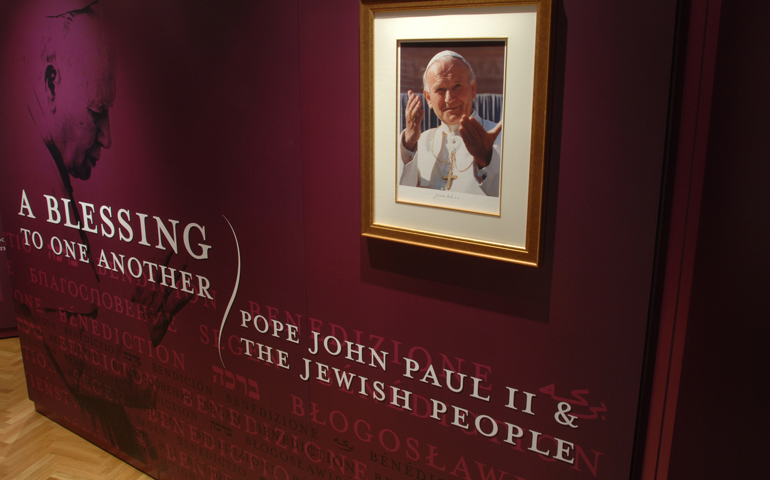
The opening panel of the exhibit "A Blessing to One Another: Pope John Paul II and the Jewish People" in the Vatican's Braccio di Carlo Magno hall (CNS/Courtesy of Blessing Exhibit)
Helping to inaugurate an exhibit at the Vatican, the chief rabbi of Rome noted just how much "times have changed."
"Seeing in St. Peter's Square the banner announcing the exhibit with an image of a pope -- that's normal -- but a pope shaking hands with a rabbi? That's not normal. It's a sign of how times have changed," Rabbi Riccardo Di Segni said.
The banner shows the late St. John Paul II and the late Chief Rabbi Elio Toaff greeting each other in 1986 at Rome's main synagogue. John Paul was the first pope in modern history to enter a synagogue.
The exhibit, "A Blessing to One Another: John Paul II and the Jewish People," began at Cincinnati's Xavier University in 2005. Seen in another 17 U.S. cities over the years, it is open in the Vatican's Braccio di Carlo Magno hall through Sept. 16.
Admission to the exhibit in the hall just off St. Peter's Square is free.
Speaking at an inaugural news conference Tuesday at the Vatican, Di Segni said John Paul "changed the course of history in a way, understanding the importance of gestures, communication and the transmission of messages in a simple and effective way."
The late pope, he said, passed from "a theological level and writing documents to a level of persons who relate to one another, even if at times it was difficult."
William Madges, a professor of theology at St. Joseph's University in Philadelphia, who was one of the creators of the exhibit when it was at Xavier University, said the exhibit's title comes from a letter John Paul wrote in 1993 to commemorate the 50th anniversary of the Warsaw Ghetto Uprising during World War II.
"As Christians and Jews, following the example of the faith of Abraham, we are called to be a blessing for the world," the pope had written. "This is the common task awaiting us. It is therefore necessary for us, Christians and Jews, to be first a blessing to one another."
Besides the photograph of John Paul and Toaff, the other iconic photo in the exhibit shows John Paul in 2000 placing a written prayer in a crevice between the stones of the Western Wall in Jerusalem, a site sacred to Jews.
James Buchanan, a professor at Xavier and another of the exhibit's creators, said by visiting the wall and placing his prayer in it -- something millions of Jews do each year -- John Paul "set a standard" for his successors. "Pope Benedict XVI did it; Pope Francis did it," he said.
The exhibit includes the zucchetto or skullcap John Paul was wearing that day and a replica of a section of the wall. Small copies of his prayer are available, and visitors are encouraged to write their own prayers on the back and slip the paper into the replica wall.
Madges said they will take all the prayers to the real wall in Jerusalem; 80,000 slips of prayer papers have already made the journey and another 30,000 are prepared for the journey. Those Vatican visitors leave will join the rest, he said.
